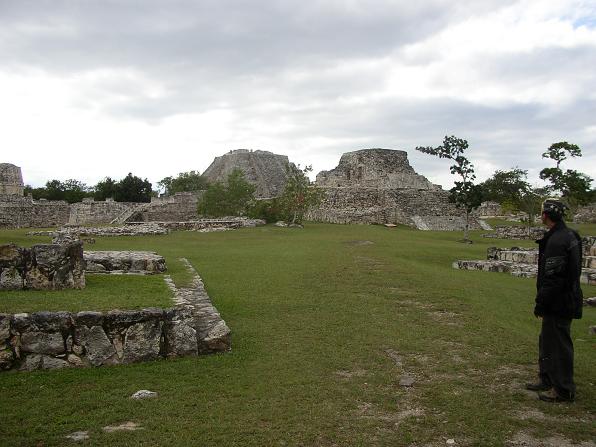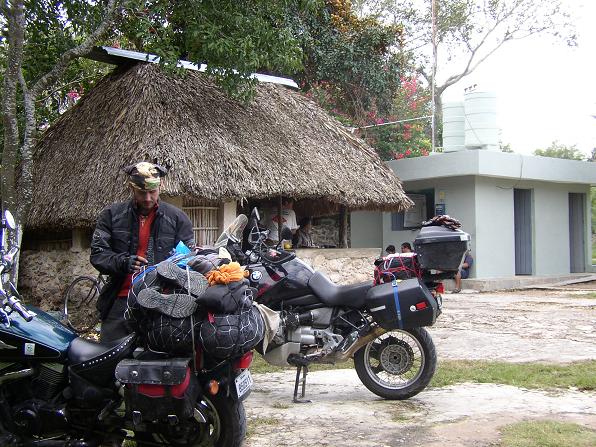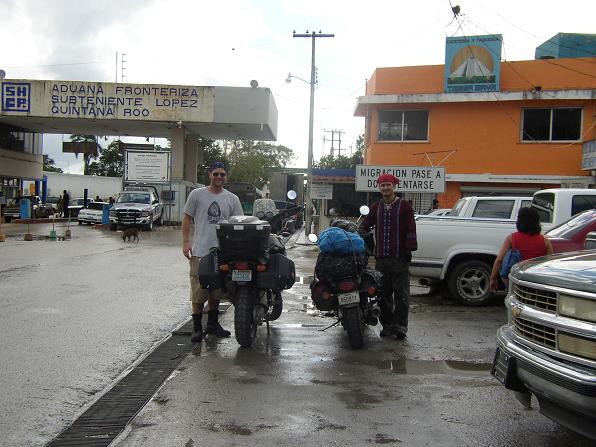Chichén Itzá, Tulum, Belize
Nick and I left Mérida yesterday morning for Cancún. Along the way we visited Mayapan and Chichén Itzá. We got into Chichén for free because it was 4 o´clock by the time we arrived and there was only one hour until it closed.
Mayapan was suggested to us by Luis, a "compadre de moto", who we met as we were leaving Mérida. He pulled up next to us in the city, and at a stoplight, asked about our travels. When we stopped a little later to check our maps, Luis pulled up again and helped us. He told us about Mayapan and suggested we go to Tepick, find his friend "Menche" and ask for the "cenotes". Turns out Luis has Mayan blood and speaks Mayopan. He here is directing us.
Mayapan is a nice quaint ruin with primitive rocks, colorful frescas and some well preserved sculptures. We had the whole place to ourselves.
As we left we had a brief, pleasant conversation with the 5-6 men that worked the entrance. They stopped their poker game to inquire about our travels and one practised his French with Nick.
Back on the road, heading to Chichén Itzá, we decided to skip the cenotes because we had to get to the park before dark. We passed a motorcyclist, travelling in the opposite direction, and we waved to eachother. It was Luis!
We stopped for good bar-b-que pork in Valladolid made it chichén by 4 o´clock. Outside the restaurant was a funny little motorcycle.
Here are a few signs I think are typical Mexican and you see them everywhere. Unfortunately I didn´t take a photo of the funniest one I saw a lot - "No dejas piedras en el pavimiento" or "don´t leave rocks on the pavement". I realized though that it actually makes some sense; when there is an accident or dead horse in the road, etc. the locals will warn oncoming drivers by putting huge rocks, brush or branches in the road, instead of the flares or orange triangles that I´m used to. Speed bumps are everywhere and some come with a warning, but most don´t. They´re know as "topes" in northern Mexico and changed to "tumulos" or "reductors" as we rode south. They´re usually placed about a 100 meters before a town or "poblo proximo". But I also learned some are not made by the government road crews; some are placed in front of businesses so you slow down and hopefully stop to buy their goods. If I were president of Mexico my first order of business would be to remove all "topes". They´re ridiculous, omnipresent and dangerous.
Here´s a particularly funny sign I encountered a lot. It´s a sign that tells you to "obey the signs".
One hour was not enough., Chichén Itzá was by far the best, biggest ruins so far. It´s huge with different sections accesible by walks through the jungle. There were lots of sculptures and rock carvings; it seemed there were very few uncarved stones.
Chichén has columns galore, some rounded, some squared, some 10 feet high, some 20, whole buildings made from columns - one building at least 200 yards wide! Their giant pyramid is in great, presevred shape. It was under construction and we weren´t alllowed to climb it. Although I don´t know if I would have wanted to.
We shared some laughs as we joked about doing a super fast tour of the place; running and reading the tourguide at the same time. Chichén was a real city; it had palaces for royalty, houses for high society, steam rooms, ball courts, pyramids for the Gods, buildings for fire rituals and food prepartions. Two huge "cenotes" provided drinking water (and were probably the reasons why that location was chosen for the city). Cenotes, I learned, were considered by the Mayans to be gateways to the underworld and were very special.
I did not take any photos of Cancún because, from I what I saw, it didn´t deserve any. Cancún seems gross and seedy, although we stayed in the downtown area, not the "zona hotelería" where all the fancy resorts are. The hotel zone is along the Caribbean and very expensive. We wanted to wake up early and hit the beach, but it rained all night and all day. So instead we made eggs and pancakes at the smelly hostel. The next day we switched hostels, to a cleaner, cooler, A/C place where we shared a room with a New Yorker named Carroll. Because it was raining so much, it left us nothing to do except go to the movies (Bond 007: Casino Royal) at the fancy mall Plaza de las Amerícas.
12/12/2006- We rode out of Cancún on 307 towards Tulum. The 40 or so miles heading south are full of luxury beach front developments. Playa del Carmen is an extension of Cancún. All the signs in front of the businesses are in English. We didn´t get to see the aqua-blue waters of Cancún, due to the rain. And it rained on and off all one and a half hours to Tulum. We headed straight for "El Mirador", the closest "hotel" to the ruins of Tulum (these ruins are unique because they are situated right on the ocean). At first glance "El Mirador" is gorgeous; right on the beach, white sand, blue waters, "palapa" huts on the sand and a restaurant on the hill above for great views. Mari, the chainsmoking owner, greeted us and I explained to her that Astro, my friend from Mérida, recommended us. We rented a cabaña for 120 pesos and hung our hammacas from the beams. The cabañas have sand floors and are of a simple construction of striaght pieces of wood and palm leaves for a roof.
It seemed like a great idea, to sleep in a cabaña on a hammaca, with the sound of the Caribbean waves crashing ashore...We went into town for a pizza, met a French couple who was bicycling the Americas, and got stuck there for a while waiting our a torrential downpour. We returned to the cabaña, lit the candles that remained there from the previous guests, and rocked ourselves to sleep. It was probably 8 or 9 pm, but with no electricity, it seemed like bedtime. Around 1am, we had both had enough. The mosquitos had arrived, probably born from all the rain, and they were eating us alive. 100% did nothing to stop them. We decided to pitch Nick´s tent outside and sleep there instead. His tent is a one-man shelter, but 2 people can squeeze into it if needed. We slept shoulder to shoulder, waking eachother up each time the other moved. It poured some more throughout the night and when we couldn´t take the hard sand surface and stuffy air anymore, we awoke to sunny skies for the first time in about 2 weeks. I skipped my bathroom duties that morning because it was so foul in "El Mirador´s" facilities. I wanted to lickity split and get to a better hotel; I was uncomfortable, my bike was salty and my clothes were damp and dirty. I waited for Nick to repack all his stuff again (this is beginning to be the norm with my streamlined packing system and his Beverly Hill Billies routine). He wanted to see the ruins, I didn´t, so we agreed to have breakfast, split up and then meet again in the border town of Chetumal, at the "Villa Deportiva".
I left without gassing up in Tulum, a mental lapse, and quickly approached empty. I moved closer to the side of the road, slowed down to 50mph, flipped on the hazards and barely limped into the tense Felipe Carrillo Puerto, with heavily armed guards on every corner. For some reason I didn´t get the feeling these cops were there to make tourists feel safer; they seemed very alert with their fingers on the triggers. Perhaps this was a known drug trafficing town, so close to the Belize border.
13/12/06- I woke up today at 7am and headed for the bathroom in our cheap 50 peso/night hostel "Villa Deportiva" only to find no running water. No shower, no brushing of the teeth. This happened in Aculpoco too, only to be turned on a few hours later. I think this is the same phenomenom I experienced as kid in Venezuala; the government shuts off the water for hours at a time to conserve the city´s water supply.
The room was sticky from the humidity and I craved a nice, cool spot for coffee and reading. So I took to the streets, it was rainy and cloudy for the umpteenth day in a row. Everything was closed, just like when I rode into town yesterday afternoon at 3pm. I was beginning to think it was a holiday. The taxis were running, beeping their horns for your attention. The Christmas music was blaring from the town´s main park, but there was barely a sole to be seen, save for the few home owners, with tired eyes, sweeping rain water away from their front doors after the "aquacero" from last night. No coffee shops or restaurants open, it was 7:30am by now. The only work at this hour seemed to be taxi-driving and sweeping, but the music was going in the park and at an elementary school where I watched a group of uniformed school children follow a teacher´s dance instructions. Finally storefronts began to appear from behind their roll-up shutters doors. Radios were being tuned to the colorful, skin-showing morning shows out of Mexico City, but still no coffee being brewed. Priorities I guess.
I walked up the main Ave. Obrégon and back down again, finally arriving at last night´s dinner spot at Sergio´s Pizza, a popular air-conditioned restaurant. I seated myself and waited and waited. Finally a basket of bread arrived to complement the "mantequilla and jalea" centerpiece. Then I ordered a coffee. It arrived lukewarm, but was good with the bread. It was refilled twice and each time the coffee was hotter. Chetumal was waking up.
I also found another Patriots fan here. This guy is a fan of #28, Curtis Martin!
14/12/06- At the border we met an Argentine who had left Miami, Fl on his Suzuki Bandit 1200 sportbike, headed for Buenos Aires. We exhanged whatever infomation we knew about crossing the border. To leave Mexico we had our passports stamped and then had to remove the sticker on the moto´s windshield and export the bikes. To enter Belize, we had to stamp our passports, once for oursleves and once for the bikes, then we had to carry all of our luggage into immigration to have them searched for contraband. It was a workout and not straight forward. We then had to leave our luggage on the Belize side of the border, unattented, go back and get the bikes, ride up to the mean border official, show our stamped passports, pass and then reattach all our luggage. Here are some photos of the border crossing, including one with Alfonso´s suzuki.
Belize is very expensive, that was the cheapest place we could find and gas is $5US/gallon. Gina, who worked there, told us in her island English, that we should eat at "Thrill on the Grill" and only the Indian food was expensive. Around the corner on Queen Street, the restaurant´s clean, new interior contrasted with it´s crumbling exterior. A TV played a bollywood movie, the Indian owner ate and watched, and the younger, beanie-wearing Matthew waited on us. We ordered the jerk chicken, mashed potatoes, beans and a Belikin beer (national beer of Belize). We talked with the owner and Matthew a little bit about the city and places we should visit. Matthew seemed overly polite, formal and uncomfortable in front of his boss; every question we had for him was double checked with his boss. The Lonely PLanet said Caesar´s, Eden´s Nightclub and MJ´s Grand were good spots for nightlife, but the owner in his Indian accent told us we should go to the Princess Hotel and Casino along the Caribbean sea. There, he assured us, we wouldn´t be bothered by beggars or possibly robbed. I was beginning to understand I should take advice with a grain of salt. When we ask for a good place to eat or a place to go out at night, people seem to look at our white faces and then suggest the cleanest, most modern, expensive places to assure we have a pleasant, safe time. I understand I guess; they don´t want us to have a bad impression of their country. But what they don´t realize is that on a journey like ours (months in duration) we can´t afford to eat $15 meals and go to expensive casinos for a beer. It´s the real, dirty, local spots that I enjoy the most; that´s where you can get a true feeling for the culture and its people.
It rained the next morning, but when the sun cleared, Nick and I packed our bikies and took off for the West part of Belize to the border town of San Ignacio. The low-lying houses on stilts gave way to nothing, open land for grazing water buffalo. Then we started to climb the green, wet hills, the road began to twist. Here the villages began again, this time more idyllic, kids playing in deep, green yards under giant trees. We passed a few menonites in their horse and carriages and reached the top of the hill into San Ignacio.
The wooden bridge had been washed out, so we waited our turn for the traffic to change on the 1 lane bridge.
At the border we outprocessed ourselves at immigration, 30 Belize Dollars because we had been there less than 24 hours. The friendly, money changers joked around with us. We asked them how they became money changers and they responded that that the government had picked the best thieves in town.
They also warned us of the very muddy, impassable roads ahead in Guatemala. Coming from the nice concrete roads in Belize, we had trouble comprehending that such a drastic change could lie ahead, eventhough we saw the mud covered trucks and cars coming through the border. The Guatemala immigration experience was a stark constrast to the formal, up front professional Belize one.
The office was a run down set of buildings followed by a colorful line of vendor huts selling food and nick nacks and then a bridge crossing a raging river (from all the rain) into an unknown land. We paid 12.40 Quetzales to a man in a booth for the bikes, but he gave us a legitimate receipt. At the next building a young boy, maybe 14 years old, was working the desk in street clothes. Older, uniformed men shuffled around in the background. I handed the boy my passport, he scanned it and asked for 10 QZ. I gave the money to him and he didn´t give me a receipt, so I asked for it and he replied there was no receipt and that I was paying to have my passport scanned. I noticed he put the money to the side and not in an official register. I smelled a rat. He refused to give me my money back.
Into the customs building to do the bike´s paperwork, I asked the officials and they laughed affirming my suspicion. By now I wanted to make the situation just. I again asked for my money back and received another "no". I went looking for some type of authority figure and found a man walking the border in uniform. I explained I had been ripped off and there was no one to talk to, only a child behind the desk. He agreed and asked me if I would be "ok" if I got a receipt and I said "yes". He went inside and I could see him and the other men talk, look outside at me, and then begin to draw up a fake receipt. I snapped a photo of the boy behind the immigration desk, to his surprise, which brought more angry looks from his father figures in the back. Then I told the other tourists there to not pay the fee unless it was accompanied by a receipt.
Finally as Nick was finishing his paperwork, the boy came out and gave me my fake, hand written receipt, which I plan to send to the Guatemalan government´s corruption office along with the photo I took. I understand being ripped off by people on the street, but by border officials behind government desks is bad.
We were on our way into Guatemala. The road was horrible, mud, potholes, rocks and people were everywhere along with pigs, dogs, horses in the street. There was no sense of order. We went about 10KM down the road in the deep mud until we decided it wasn´t such a good idea; we might get stuck in the mud and end up camping in the muck. So we turned around and went back to the border town of



























